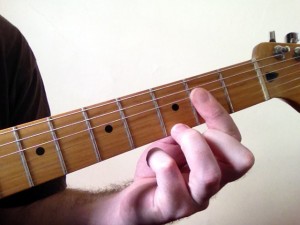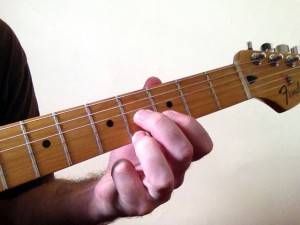Blues Rhythm Guitar Essentials – Part 2
In Blues Rhythm Guitar Essentials – Part 1 we looked at the structure of the 12 bar blues and the 12 bar minor blues, swing and spread rhythm. Here we will learn further essentials skills to playing great rhythm guitar in the blues.
Chord Shapes
Apart from the spread rhythm you can also use the dominant 7th chord shapes and their variations as shown in Blues Rhythm Guitar Essentials – Part 1 . For a blues guitarist it is essential to know all the basic dominant 7 chord shapes and their locations on the guitar neck. If you’re still unfamiliar with your bar chord shapes and locations check out Playing Bar Chords In Songs.
It’s good to think of the three dominant 7 bar chords as I IV and V as this makes it easy to transpose (change to another key). If you can memorise the 2 patterns below and your bar chord locations you should be able to play the chords of the 12 bar blues in any key.
For further info on I IV V chords in 12 bar blues check out 12 Bar Blues, Rock n Roll & I IV V.
Apart from these shapes there are also several chord variations which are handy to know. These shapes can be moved up and down the guitar neck to fit any key just like the bar chords.
Chord Rhythms
Here are a few chord rhythms that work well in blues songs. If you’re playing with another rhythm guitar or a keyboard player the “less is more” approach is best. You can strip the rhythm back to just strumming short chords on beats 2 & 4 of the bar which keep in time with the snare drum. This style of rhythm guitar was used extensively in 50s and 60s R n B and music produced by Motown. In general the chords work well with just the lighter 1-4 strings being used.
|
2 & 4 Rhythm | Download |
You can of course mix things up a bit more by varying the rhythms. Apart from varying the rhythm you can also add chromatic approach chords either one fret above or below the target chord. This approach also works well in funk music. An extreme use of this is to use multiple chromatic chords to move from the I to the IV chords. The example below shows you all these ideas together.
|
Chromatic Chords | Download |
Blues Guitar Riffs
Apart from riffs based around the spread rhythm patterns you can also play riffs based on the notes of the chords and the pentatonic/blues scales. Check out the example below and see if you can play them in different keys.
|
Blues Riff | Download |
You can even try mixing the chords with the riffs to create a more full sound blues/rock rhythm guitar sound. Again try these ideas in different keys.
|
Blues Riff Chords | Download |
Arpeggios
Apart from just strumming the chords can also play arpeggios. Arpeggios work well on slower songs and are used quite a lot in soul and old school R n B ballads that are based on the blues. Note the 12/8 time signature in this example which means there are 12 8th notes in the bar. The count for this rhythm is “1+a 2+a 3+a 4+a” or “1 and A 2 and A 3 and A 4 and A”.
|
Blues Arpeggios | Download |
Turn Arounds
One final blues rhythm element is to vary the chords used in the last 2 bars of the 12 bar structure. This is called the “turn around” as it turns the progression around back the start of the chord structure. Try each example and see how different they sound.
|
Blues Turnaround 1 | Download |
|
Blues Turnaround 2 | Download |
|
Blues Turnaround 3 | Download |
So now you’re armed with this essential blues rhythm guitar knowledge head down to your local blues jam and see what you can come up with in between your solos. You will find it almost as much fun to play rhythm guitar as it is to play lead!













